A standard middle-class Australian dream is to emigrate to Australia with nothing, to study hard at a good university, to find a good job, to be a good position, to have a good salary. At the same time, buy a villa surrounded by a white fence in the suburbs, get married and have children, and have a big dog. In exchange for this dream, there is only one condition: willing to give up.
Maybe the Australians will never understand why the Chinese are never satisfied and always fighting. Without greater ambition, they argue, it would be comfortable in Australia.
But at the moment, the audit process slows, the number of people across the bridge is soaring, and international students expand and close. In the future, permanent residence may also be subject to Australian values and English proficiency tests. How many immigrants who survive in the gap have truly realized their "Australian dream" by keeping the immigration policy in abreast of each other, and how many of them have come to terms with their own "Australian dream"? What does the Australian Dream mean to them? How many people gave up the "Australian dream" and returned to their own "Chinese Dream"?
One, how many people are chasing the Australian dream.
The Australian Immigration Service issued a record 8411187 temporary visas and 183608 permanent visas between 2016 and 2017, according to data.
According to the nationality of visa applicants, the largest source of immigrants in Australia is India (21.2%), followed by China (15.4%) and the United Kingdom (9.3%).
Of the permanent immigrants who came to Australia between January 2000 and August 2016, about 95000 Chinese went to Australia through the family migration program, a proportion that exceeds that of other countries.
In a survey of 1000 immigrants, more than half (55%) said chasing the Australian dream was not an easy task, aside from what most people see as the benefits of immigration.
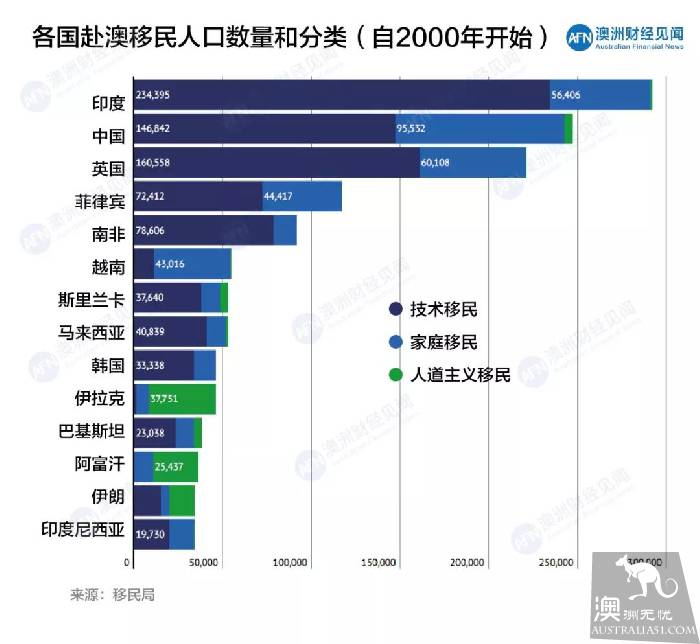
Second, the Australian Dream starts from home ownership.
In the past, the typical Australian homeownership dream was a 1-4-acre (1000-square-meter) stand-alone house (usually single-story) on the outskirts of the city, with gardens and backyard hangers and barbecues.
Now, for immigrants, the first step to realizing the Australian dream is to have a small home of your own. Of the permanent residents who arrived in Australia after 2000, 54 per cent have become homeowners, slightly less than the 65.5 per cent of Australian residents.
Geoff Brailey, a social researcher at McClindell research firm (McCrindle), said buying a home was the most attractive for Chinese immigrants, with more than 70 percent of Chinese coming to Australia and putting years of hard-earned savings into the housing market.
While the number of new immigrants has increased, the proportion of people who are able to realize their dream of home ownership in Australia has fallen as house prices soar. Coupled with tight lending policy, new immigrants into the Australian real estate market has become more difficult.
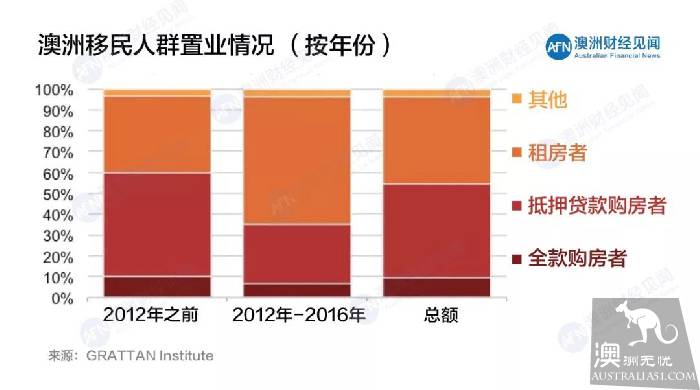
In the first five years of 2016, the proportion of new immigrants has fallen. About 35% of new immigrants bought homes, up from 40% in 2011. According to major cities, although the new state has the largest number of new immigrants, the number of new immigrants is the second-lowest, at 49.5%. New arrivals in the Northern Territory had the lowest home ownership rate, at 37.4%.
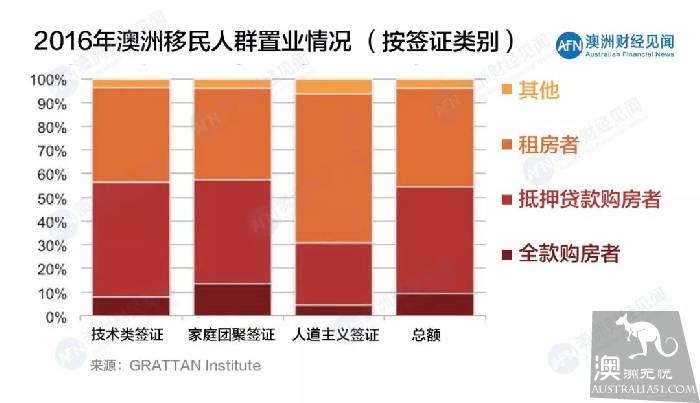
Nearly 60 percent of them moved to Australia on family or technical visas and bought homes, compared with less than 1/3 of humanitarian migrants.
The main reason is that skilled immigrants and family migrants tend to earn more money and realize the Australian Dream more quickly economically.
Population experts said most of them moved to New and Victoria as a result of the influx of skilled immigrants into the housing market, while pushing up local housing prices.
In the six years to 2016, the most common destination for immigrants was Melbourne, with a total of 12431 people, according to data. Sydney is the second largest gathering place for immigrants, with a total of 8780 people. Over the same period, the greater Sydney region had the highest median house price in Australia, at A $1150357, making housing affordable for humanitarian migrants, forcing them to move to remote areas.
Some economists believe immigrants have pushed up house prices and rents and even increased housing affordability in Australia. The estimate is that every 1000 new residents in Australia are expected to need between 450 and 550 new homes. The new state has just reached that level, with more than 500 homes per 1000 inhabitants.
In 2016, 42% of immigrants were still renting, unable to live up to the Australian Dream.
Third, the "Australian Dream" of immigrants begins with employment
Australia's Treasury and Home Affairs Department reported that the majority of immigrants to Australia before 1995 were low-skilled migrants, but 2/3 (64.5 percent) new jobs have been created in Australia over the past five years.
However, immigration did not replace the Australian local labour force, and the (Productivity Commission) study by the Productivity Council found that during 2000-2011, immigration did not help local workers to find employment, but did not cause any harm.
In terms of pay, in 2016, Australian immigrants earned an extra A $650 / 999 a week. However, more than 1/4 (27 percent) of them earn just A $300 a week, while more than 1/3 (35 percent) of skilled immigrants earn more than A $1500 a week.
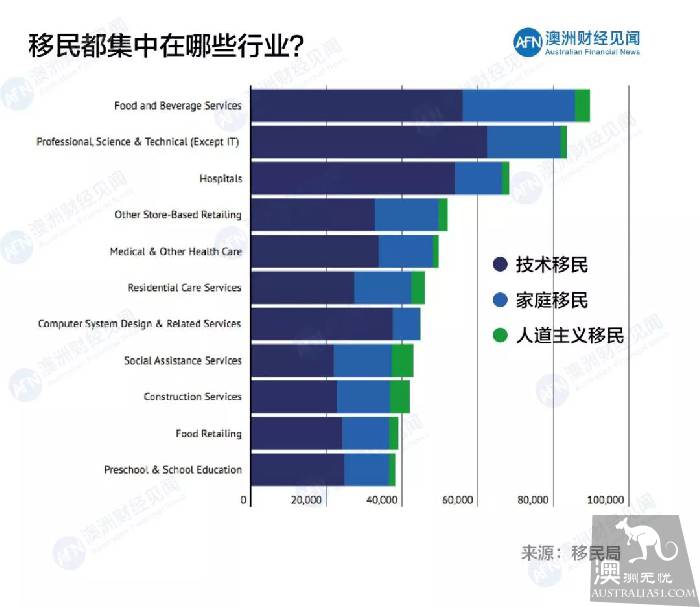
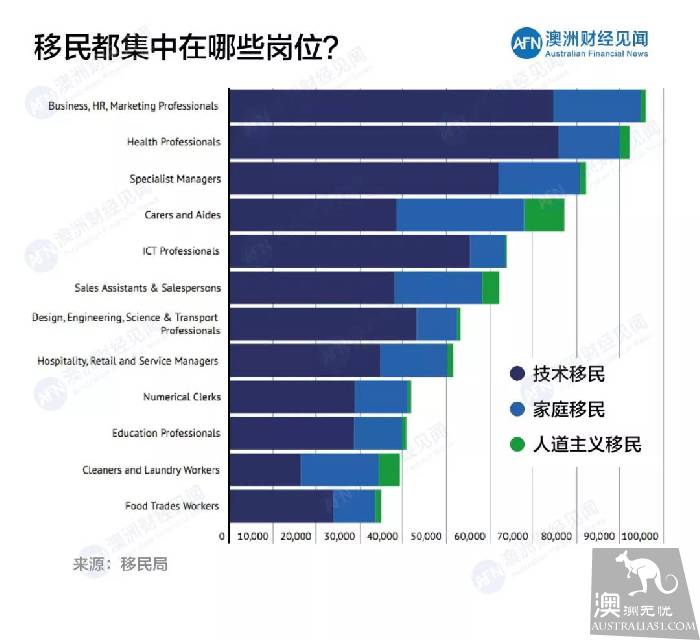
As shown in the picture, the immigrant population in Australia is the most engaged in the service industry. So has the Chinese achieved their own "Australian dream" in the workplace?
In Australia, the proportion of Asian-American chief executives of private companies is 1.9 percent, compared with 4.2 percent on boards of Central Asian descent, according to a 2016 study by Australia's Diversity Council. The "workplace ceiling" between immigrants of Chinese and even Asian descent and mainstream society (barriers to career advancement due to different races) is seeing a growing trend.
According to an Australian National University employment survey, under the influence of employment protection policies, Chinese Americans on average submit more than 68 percent more job applications than local applicants in order to get jobs. Even if hired into the company, getting promoted to a senior executive is "as hard as flying."
This is mainly because Chinese Australians still have too little influence in mainstream society. Australia in the past, the number of old overseas Chinese, the second generation and the third generation without any family background, poor language, white-collar is not easy. But now a new generation of Chinese immigrants with a high degree, good English, a lot of white-collar workers, but because of the short-term unable to join the mainstream society, enter the higher level to pursue the "Australian dream" very few people.
Fourth, immigrant "Australian Dream" begins with language
In terms of language communication, skilled immigrants have the highest percentage (92%) among those who have attained proficiency in English. The proportion of families and humanitarian immigrants with proficiency in English was lower, at 73% and 66%, respectively.

Previously, Australia accepted as many as one hundred and ninety thousand permanent immigrants a year, and although they needed to prove that they could understand English, the spouses, children and other family members accompanying them could not understand it.
Multicultural Secretary Alan (Alan Tudge) described this as a "worrisome situation" in which "nearly a million" Australians do not speak Australia's national language now.
In 2016, about eight hundred and twenty thousand permanent residents of Australia could not speak or speak English at all, compared with three hundred thousand in 1981.
According to Alan Tudge, as many as 1/3 of people in some districts "cannot speak or speak Australian national languages at all." Australia's government is determined to ensure that Australia does not repeat the mistakes of some European countries, where migrants are isolated from "parallel communities".
Now, Australia's government is considering a range of options, from mandatory language courses for people seeking permanent residency to the design of a new English test.
In the future, tens of thousands of immigrants, the Australian Dream, will start with language learning.
Fifth, anti-immigrant voices rise to the "Australian Dream" fear of stifling
Australia's Home Office reported fewer than one hundred and sixty three thousand permanent resident visas issued in FY17 / 18, 21,000 fewer than in the previous fiscal year, a drop of more than 11 percent, and a 10-year low in immigration.
Interior Secretary Peter Dutton said the government has agreed and will launch immigration cuts on the grounds that traffic jams and housing affordability issues remain unresolved.

For every 1 percent increase in Australian immigration, the Treasury said political sensitivity to events such as traffic jams, shortages of other infrastructure such as schools and hospitals, and fears of rising housing prices rose. However, because immigrants tend to be younger than the average Australian workforce, some of Australia's aging demographics have been curbed, but the power to cut Australian migrants is still surging.
How much would it be appropriate to cut? No answer!
Liz Allen, a demographer at the Center for Social and methodological Research, says that once people start discussing population policy, a question naturally arises: "how many people is the most appropriate number for sustainable development in Australia?"
In her opinion, the number is incalculable. The introduction of a policy that requires calculating the economic, environmental and social sustainability impacts is very difficult, as Australia and other countries continue to innovate and grow in areas such as agriculture and trade. In the future, Australia is ageing and jobs such as teachers, construction workers and hospital workers need to be emigrated.
Today, Australia is going to top-down, from official to private, to the great Australia's bright prospects for unprecedented reflection and doubt. The future of Australia's immigration policy is likely to depend more on what the parties call population policy.
Six, how many people turned away from the Australian dream
According to the 2018 White Paper, 73% of the world's Chinese students plan to return to work after completing their studies. In Australia, 83% of international students choose not to stay in Australia, but to leave Australia and go elsewhere.
Overseas talent platforms also reported that more than six hundred thousand people are expected to return to China in 2017, meaning that more students are likely to return to China this year than they have sent out.
Ten years ago, for every seven people sent out, only one returned home; now, for every seven sent out, eight can come back.
The survey showed that 54.8% of the returnees returned the first reason is that China's economic situation is good.
Not everyone is staring at China's GDP, every day, but living abroad, and you will hear China. every day. No matter what courses, teachers always come out of China proportion or comparison. There is no reproach that China's international status is now different from what it used to be.
In the past, China was a poor and backward country in the eyes of the Tuao people, and it was no different from the present North Korea. Now, sitting on Uber in Sydney, drivers are always talking about how rich you Chinese are.
With the rapid development of China, Australians are dizzying: sharing bicycles, sharing portable battery, sharing printers. In Australia, a cash-free society has just begun. At home, it is no longer necessary to bring out a wallet and buy a big cake Youtiao that can also be paid for on mobile phones.
In the past few years, most of the reasons why returnees of the same age were asked to return home were as follows:
- I can't find a suitable job after graduation.
- I got a job after graduation, but I can't get a job visa.
- I still don't like life abroad.
After returning home this year, I met many sea turtles who had already settled in Australia and asked them why they had returned home. The reasons are as follows:.
- He got the Chinese investment and returned to China to start a business.
- See the ceiling that continues to work in Australia, choose to switch jobs to return home
- Feel like I need to know more about China so that I can seize more opportunities in the future.
Although Australia is still fascinating, China is also attractive.
There was a heated speech by international students who described the pursuit of the western world to the extreme. After the uproar, some people began to reflect on how far our Chinese heart wandered to the west. Chinese Dream is one thing, Western dream is one thing. Half sea water, half flame. Some wake up in the west, others chase dreams in the east. The first half of my life is PR, Australia. Where will my second half be?